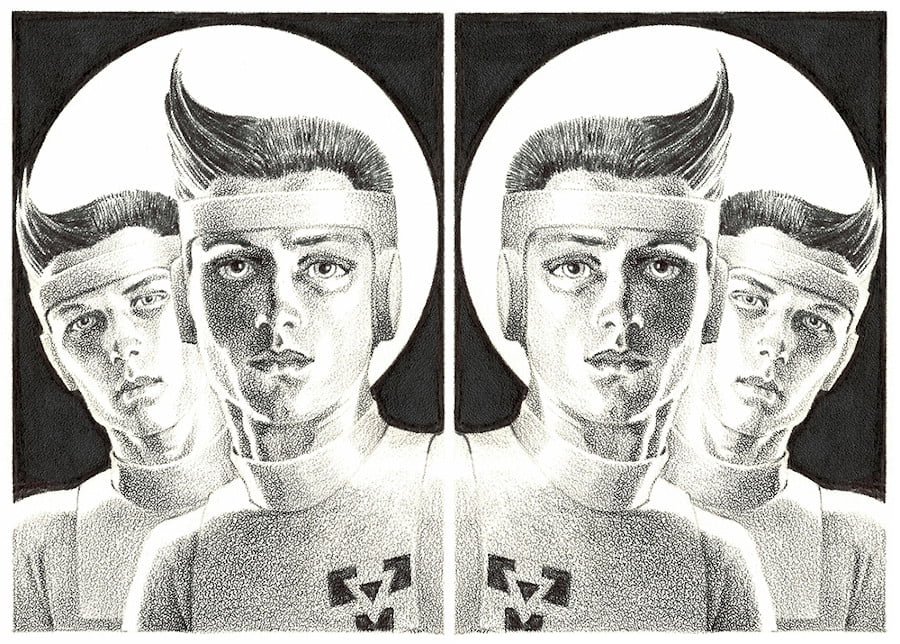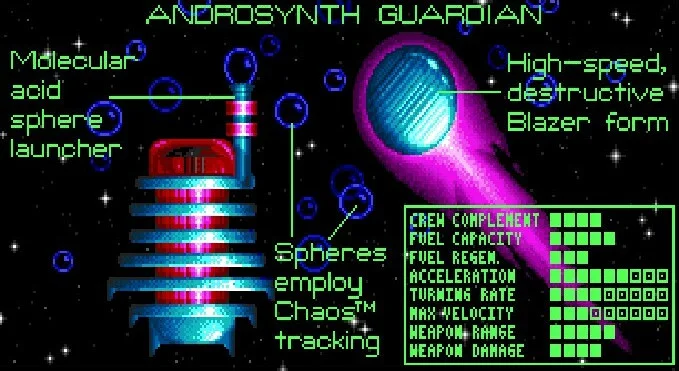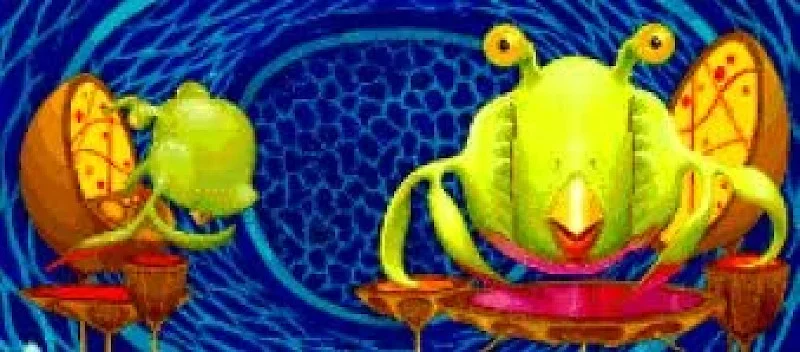Talking about Star Control 2 is a process of pulling apart an encyclopedia of a game and turning all the phrases in it around until they catch the light. A sprawling epic you can fit on a floppy disk, it was one of the most thoroughly crafted games I ever experienced, supported both by its own historical text (Star Control 1), supplementary text (the manuals) and even the first version of The Author’s Twitter (a set of IRC interviews with the developers back in the days before twitter was a thing). Then there’s the implied spaces of that text, where just by dint of being science fiction made by dorks in the 90s, and drawing on a trope space like that with no real shame, there were a host of things in this universe that even one-note gag characters presented to be the point-and-click adventure temporary problems you routed around were still imbued with personality and culture.
It was also that particular characteristic of writing of the time, which I saw as well in other ‘expansive’ universes where every individual character had basically a single hook to get them into your head. In the same way that you can point at each member of the Transformers core cast as a set of speech tics and single personality traits, it’s not hard to look at the cultures of the Star Control 2 universe as kind of two simple ideas mashed together. Xenocidal spiders, capitalist slavers, sweet plants, blue lesbians, miscellaneous shitposters (malicious), miscellaneous shitposters (harmless), lovecraftian fish — they hold together simply, and they do their job.
I talked about the Ur-Quan, the Thraddash and the Dynarri (a culture represented by an individual). I mean ostensibly, I do want to talk about all the interesting cultures of Star Control 2, and probably get to the Supox as well, but there’s one culture, one group, that deserves special attention for being an absentee. It’s not like the Taalo, who you only know of through their absence — an alien culture you encounter in the backstory of the Ur-Quan. Rather, it’s one of the cultures you met in Star Control and then, in Star Control 2…
are gone.
The story in Star Control 2 of the Androsynth is a lovecraftian horror story that culminates in a whoopie cushion sound. You’re trying to rebuild the old alliances you had from Star Control 1, and one of the cultures you look into are the Androsynth, who you know have off-they-fucked to their own sector of space, around the star Gamma Vulpeculae. When you head thats-a-ways, you wind up exploring a completely abandoned, Marie-Celeste style story where the entire Androsynth population of their home planet is just… gone. Eventually probing through their research materials, you find something that then freaks out one of your own scientists so bad they need to be executed or they’ll endanger someone else on the team…
It means that you don’t see any Androsynth. You know they were around, they hated us, they had their own planet and their own cultures and their own cities and ships, and… then that was it. They’re gone. Weird. Why? Well, we’ll get to that. Because there’s a reason we’re talking about them now, and here, in Pride Month.
What were the Androsynth, when they were at home?
The Androsynth, presented in Star Control 1, were uh, slaves. They were human clone slaves that we made, on earth, and spent about a century being oppressed, and maligned and then when they hit a critical mass of population, they had a revolution and banded together and escaped and wanted nothing to do with us. Working with humanity in Star Control 1 demonstrated an immense act of generosity on their part, what with, you know, the slavery and all.
The Androsynth were one of your big-brain science fiction narrative ideas, the kind of thing you’d see at the heart of a Star Trek episode, but instead of it being aliens with rubber foreheads that were meant to represent humans, they were just humans. We developed cloning technology, immediately saw ways it could be used to create a cheap labor force, exploited that, got attacked for it, and then when they left us alone we turned to them for help because we needed it due to having, y’know, been the kind of culture that would rely on a slave population. The Androsynth had most of their individuality erased through their clone origin and the behaviour of their oppressors, which meant that when they broke free from us, they did what they could to individualise themselves — wild hair colours, bright clothes, punk aesthetics, and extremely individual hyperfocuses that they used to distinguish themselves from one another.
They were space queers.
This isn’t subtext, by the way: The Androsynth were originally conceived, by Paul Reiche, as a monosexual culture, where they just had dudes, and those dudes who could see one another as equals and partners and lovers, would inevitably and naturally see each other as sexual options. The result being a whole race of gay space punks. The manual (in a section Reiche did not write) made fun of them for this – describing them as fashion designers and hairdressers in space. This wasn’t really the intent – Reiche had been informed by his first dealings with publically out queer friends, which meant that he wanted to enthusiastically centre their ideas, and their struggle in his fun videogame where a bird could insult a hippo to death.
Look, there’s an enthusiasm to it, and you can find it if you go reading the Androsynth lore, the amount of writing about it. The history of humanity in Star Control 2 is inextricably linked to the story of the Androsynth, complete with the development of human religion, multiple wars, and the collapse of the pre-spacefaring human culture. And… like, yeah it’s all a bit hamfisted and a bit 90s, and then the Androsynth were written out, because they were seen as an adequate and interesting sacrifice to the greater narrative, though there was a vision of their return as a kind of potential hook for the sequel.
The Androsynth were an honest and sincere attempt to put queer representation in a game by someone who enthusiastically wanted to put it there, and was disappointed by that representation being turned to mockery and cruelty. Reiche has, over the decades since the games’ release, expanded on the Androsynth, and not once seemingly changed his opinion on how they should be a respected culture that gives queer people a space in the world, and even described that there should be lesbian and ungendered Androsynth. After all, if the mechanism for reproduction and the structure of your society are both decoupled from our existing superstructure, why the hell would anything of our ‘default’ matter?
Also, yeah, obviously an oppressive religious state would clone uh… ‘female bodies.’
I play a lot of old videogames. I play a lot of old games, and partly that’s because I am, myself old. How old? Well, My ongoing project to play everything in my Steam Library, the Game Pile of Yore, that has managed to successfully crest 50% of the games in my library, now includes a lot of games that are ‘classic’ and ‘vintage’ because those games are themselves, over fifteen years old. The gap, in my mind, between the games of 1997 and 2007 aren’t small — in 1997 you had the last trails of pixel and 2d art, before that was retro, and the early stilting days of 3d, almost no MMORPGs, it was a lot more atomised, while 2007 had… well, Steam. Starting out, but Steam, c’mon. It means that even small gaps in time have what feels like wildly different cultural contexts.
But even then, the Androsynth are from Star Control 2, which presents in its science-fiction narrative space that they also had room for Queers! In! Space! even in a hamfisted way, and they were cool and they had a ship that you could use, in the first game, to cheese wins on Chenjesu ships by getting rammed into their combat port. Paul Reiche hasn’t backed down from this group, and has even spoken about how he’d like to have done a better job of handling it.
When talking about queer culture of the 90s there’s this urge to highlight the things that we attached to that mattered a lot, even if it can look a lot like crowing over crumbs. And yeah, this is a crumb. The Androsynth are cool, you can play them in melee, they’re really fun to play, shame about how their only place in the plot is in the rear view mirror.
Oh right, the sudden disappearance. What was that about…?
…suddenly, the Orz show up. They are *funny* fish *campers* with *strange* ways of speaking and *dancing*, where the translator system has just broken the hell down. I’ll talk more about the Orz another time, because I like them a lot, but for now, the important thing is to know that they’re a great ally, they provide a useful ship, and if you ever ask them about the Androsynth twice, they will kill you.
The entire Androsynth culture disappeared and trying to find out why will result in the Orz, who definitely seem to be responsible, turning on you relentlessly. And since it’s a time of war, you just… kinda… don’t ever find out more about what happened. The Androsynth’s story in Star Control 2 is a punctuation mark.
An end.
They were literally a trail of crumbs.




1 Trackback